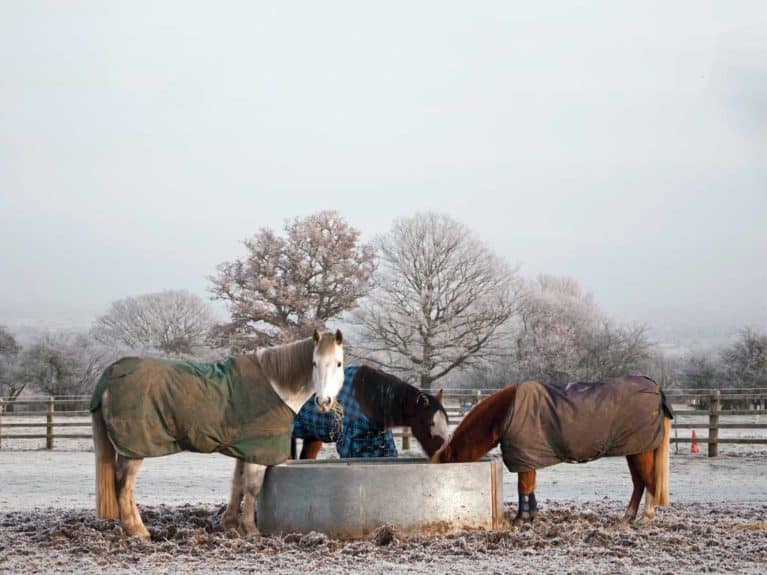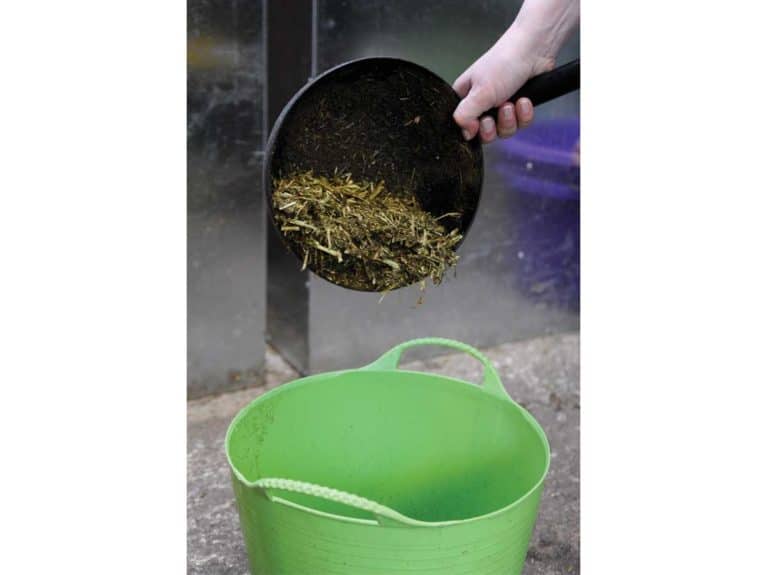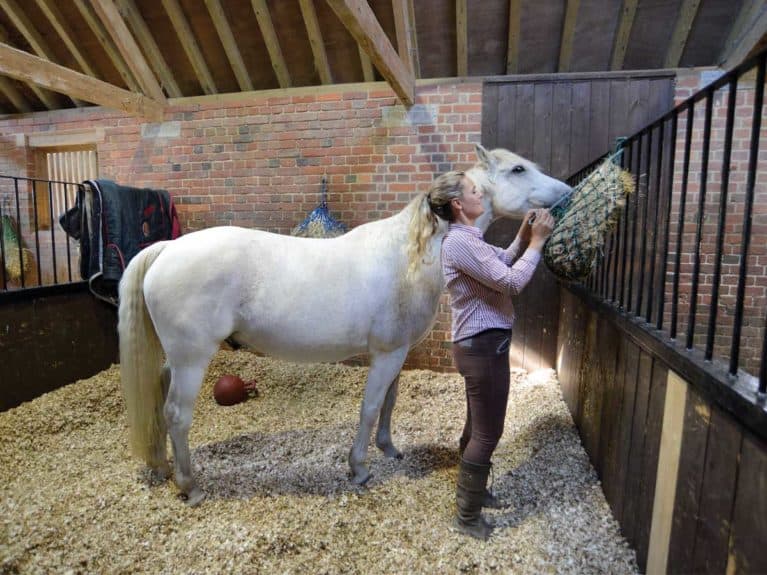The challenges of winter can sometimes mean rethinking how you feed your horse. H&R’s panel of experts solve some common problems

Finding a winter feeding regime that suits your horse can be quite a juggling act. There are so many things to factor in, from considering his weight and maintaining his respiratory health to boosting his body temperature and providing mental stimulation, that it can be hard to know the best option. Luckily, the experts are here to help – we’ve asked four top nutritionists for their best winter feeding advice.
Boredom busting
The winter weather will often mean your horse has to spend more time in his stable in order to preserve paddocks and protect him from the elements. Being confined to barracks provides far fewer opportunities for stimulation than being turned out, meaning it’s easy for him to get bored. Stephanie Mapletoft explains how you can tailor his feeding regime to keep him entertained…
“Your horse is used to foraging for his food when he’s outside, which means he’s constantly moving around. To help keep him busy when he’s inside and replicate natural behaviours, make use of food stations. You can do this by tying several haynets up around his stable – moving between them will mimic the foraging he would do in the field. To make it more interesting, you could also hide chopped apples or carrots in them for him to find. Offering a variety of fibre may help keep him occupied, so in addition to haynets you could give him some chopped fibre in buckets.
“Stable toys, such as treat balls, can be used, too. If he’s on a calorie-restricted diet, fill food-related toys with fibre-based treats that are low in sugar and starch. Putting vegetables, such as carrots and swede, on a rope and hanging it in his stable will also give him something to play with.”
DID YOU KNOW? Splitting your horse’s feed into several smaller meals isn’t only better for his digestive system, as it reduces meal size, but also helps to break up his day.
TOP TIP – As horses are herd animals, ensuring your horse has a friend nearby while he’s in the stable can help to keep him settled.
Supply and demand
Even if your horse is turned out during the winter, the reduced grass growth means that it’s unlikely he’s receiving as much energy as he would at other times of the year. This means it’s often necessary to supplement his diet with additional forage and feed. Becky Hollows shares how to use this to your advantage…
“As temperatures drop, maintenance energy requirements increase, particularly in wet, windy weather. If you have a good-doer, you can use this increased energy requirement to your advantage. Try not to over-rug and instead use the cold to help shift any extra kilos. It’s natural for horses to drop weight in the winter and put on condition in the spring. Those who maintain their weight reasonably well over winter can often be fed a low-calorie, high-fibre feed at the recommended levels or, alternatively, a broad-spectrum vitamin and mineral supplement or balancer.
“Poor-doers or horses in hard work will often require careful management to maintain condition when the weather gets colder. You may want to consider a higher calorie conditioning feed that will help supply the extra nutrients he requires. Supplementing oil or fat is a good way of providing your horse with the additional calories required for maintaining condition.
“Older horses with poor dentition can struggle to efficiently chew and digest fibre from hay or haylage, so consider switching to a forage replacer. These often take the form of a short-chopped fibre, but horses with particularly poor teeth may benefit from a soaked feed.”
DID YOU KNOW? Oils and fats provide more than twice the energy of the same amount of cereals.
TOP TIP – It’s important that your horse has access to plenty of fibre at all times, even in his field if the grazing is poor. This helps satisfy his psychological need to chew.
Plenty of fibre
Horses are trickle feeders and are designed to eat for at least 16 hours a day, so it’s important to make sure your horse has plenty of forage at all times. This is particularly important when he’s stabled, as he won’t have any access to grazing. Forage should form the main part of his diet – he needs to receive at least 1.5% of his bodyweight as fibre per day. Supplying ad lib forage, such as hay or haylage, will not only help keep him healthy, but also prevent boredom because eating it will keep him occupied.

Feel the heat
A drop in temperature can result in many horses struggling to maintain weight. Combating this through feeding can be difficult if your horse is prone to fizziness, so it’s important to choose the correct feed. Dr Tom Shurlock explains how to balance condition with calm behaviour…
“Horses lose condition during the winter if the energy their feed provides isn’t enough to match what they need to stay warm, especially if they can’t generate extra heat by moving around, because they’re stabled more. This means they have to use their fat reserves to generate heat, resulting in a loss of condition.
“Many conditioning feeds contain high levels of starch, which is a source of quick-release energy. However, feeding a high-starch mix will fuel your horse while his activity level is low. In comparison, fibre is fermented in his hindgut and is much more sympathetic to his digestive system. As it breaks down, it generates slow-release energy and heat.
“Superfibres, such as beet pulp, alfalfa and soya hulls, provide a highly digestible form of fibre. They have higher fermentation rates than forage, so can supply more energy without the need for starchy feeds. Supplying a greater level of slow-release energy maintains condition without fizz.”
Staying warm
All warmblooded creatures have what’s known as a zone of thermoneutrality – within this band of temperature, your horse can maintain his body
heat through normal metabolic processes. However, colder than this and he has to burn fat reserves and shiver to warm up, which uses more energy. He needs to remain within the zone to hold condition, perhaps with the help of a rug during the coldest weather, so feeding fibre that generates internal heat will make this easier for him.
DID YOU KNOW? In an inactive horse, 80% of the energy he generates is used to maintain his body temperature, so using techniques to supply or preserve heat in other ways, such as wearing a rug, will conserve that energy.
Breathe easy
Stables can be a dusty environment, but finding ways to maintain your horse’s respiratory health is important, particularly when he’s spending more time inside over winter. While respiratory problems should be treated in conjunction with your vet, Charlotte Wilkinson has a few simple ways to manage your feeding and forage regime…
“Most respiratory problems are caused by a chronic allergic reaction to moulds and spores in dust and hay. Reducing your horse’s exposure to these is important. Even if your stable and hay look clean, they’ll still contain allergens, so the best way to reduce exposure is to turn your horse out as much as possible. However, if he can’t be turned out all the time, make sure his stable is well-ventilated.
“Feed your horse’s hay and hard feed from the floor if possible. Recent research has shown that horses fed using haynets have higher numbers of inflammatory cells in their airways than horses fed off the floor. This is because feeding forage at floor level, or from a low hay bar or manger, allows the dust to fall to the bottom and reduces inhalation of spores. There are also herbal supplements on the market containing a number of ingredients, including garlic, that are designed to help maintain the airways and lungs, and support immune function, that may offer some help.”
DID YOU KNOW? Sending a sample of hay for a hygiene analysis will determine levels of moulds, yeasts and bacteria that produce spores.
TOP TIP – Steaming or soaking hay for 30 minutes will reduce the concentration of moulds and spores.

Spot the signs
If your horse suffers from respiratory problems, breathing in high levels of mould and spores will cause his immune system to launch an excessive response. This results in coughing and wheezing, flared nostrils and increased effort to breathe, because his airways have become inflamed. Some horses may have a visible heave line over their flanks, while others may have a snotty nasal discharge. If your horse suffers from respiratory problems, speak to your vet about the best course of action.
TOP TIP – Keep an eye on your horse’s weight, as any excess will put additional strain on his respiratory system. Use condition scoring and a weightape to monitor for any changes in the wrong direction.















